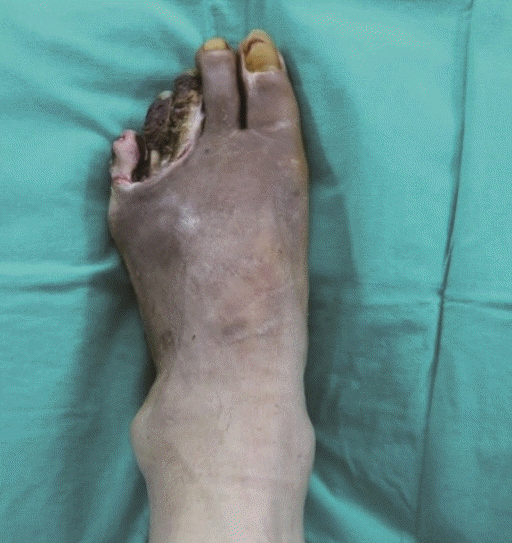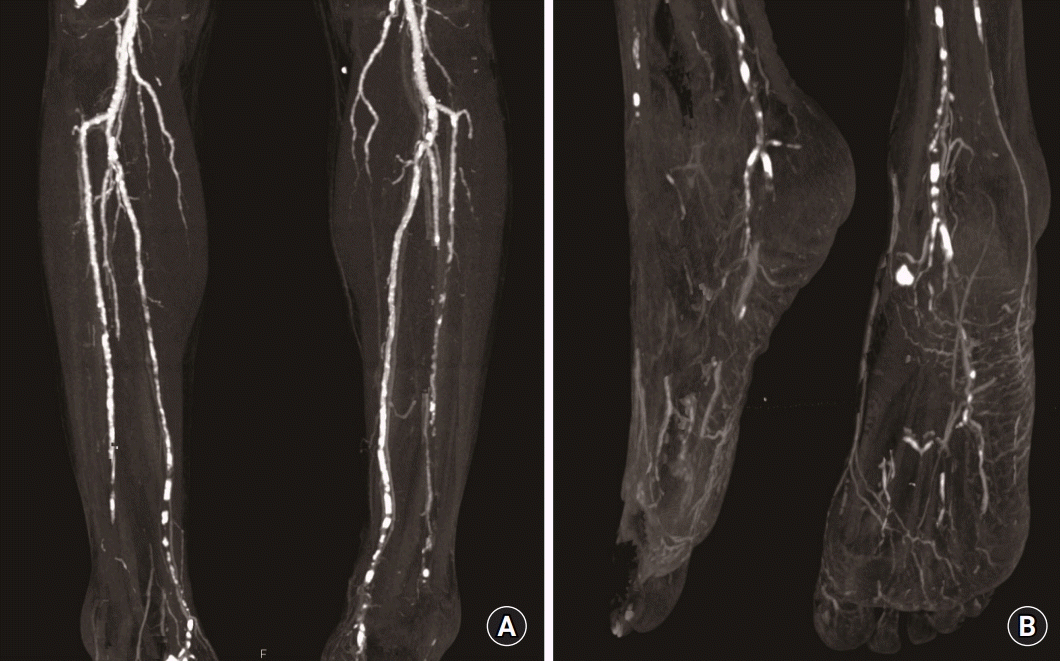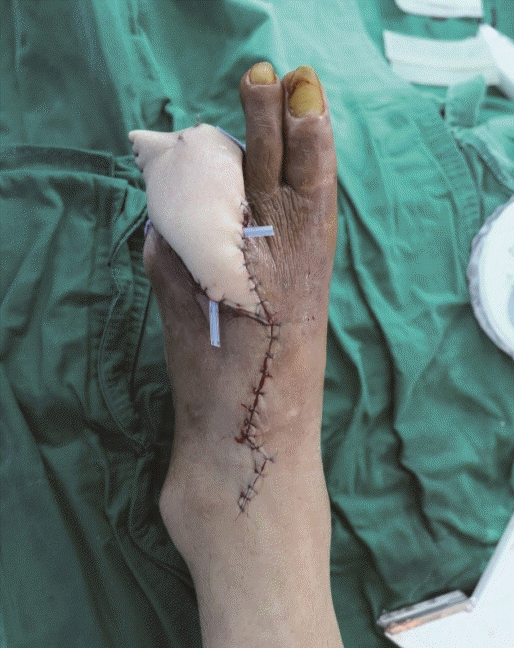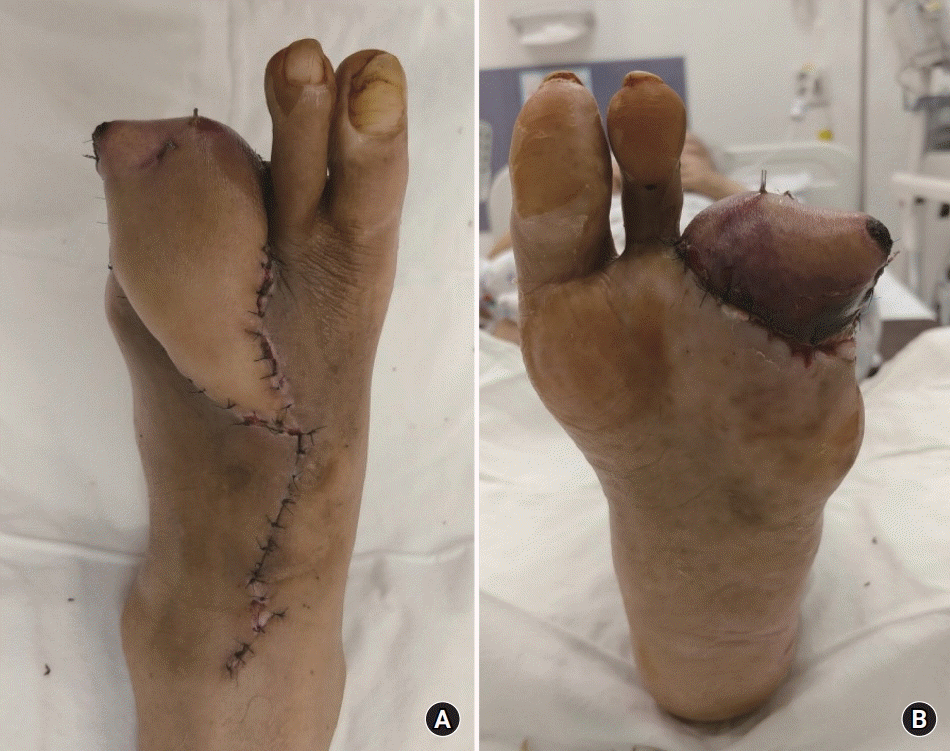A 72-year-old male patient with uncontrolled diabetes was admitted to our hospital for a severe diabetic foot with necrosis of the third and fourth toes of his left foot (
Fig. 1). Physical examination of the wound revealed that necrosis had progressed and wide debridement and amputation of the distal phalange were inevitable. Because the patient was determined to save his foot, we examined the vascular conditions of both lower extremities by three-dimensional computed tomographic (CT) angiography and hand-held audible Doppler ultrasound before deciding on the main surgical procedure. The CT angiography revealed a multifocally calcified anterior tibial artery (ATA) and posterior tibial artery (PTA) (
Fig. 2A), and an invisible DPA (
Fig. 2B). Prior to the surgical attempt, endovascular intervention, balloon angioplasty was performed to restore blood flow for better wound healing. However, revascularization of the ATA and PTA failed at the level of the plantar arch of the foot due to severe calcification. We considered that all three vessels were poor candidates for reconstruction, but the strong sound of the reverse flow of the DPA was detected by hand-held audible Doppler ultrasound. Then, contralateral anterolateral thigh (ALT) free flap reconstruction of the defect was conducted. After en bloc debridement, the distal phalanges of the third and fourth toes were fixed with Kirschner wire. To examine the condition of the recipient vessel, the DPA was dissected and traced. However, the intraoperative findings showed that the DPA was rigid and thick with no elasticity (
Fig. 3A). When we cut the DPA into sections, we observed complete obstructions with severe calcifications at each end (
Fig. 3B). We could not observe any blood flow through the lumen of the proximal end, but very weak blood flow was detected at the distal end of the DPA. The proximal end was additionally resected in a cephalic direction to find adequate blood flow, but flow was not observed. Since the pulsatile sound of reverse flow was heard at the distal end of the DPA, we attempted to carefully remove the calcified fragments with jeweler forceps to restore blood flow (
Fig. 3C). After several attempts to remove the calcifications and additional irrigation with urokinase and heparin solution (
Fig. 3D), limited reverse blood flow through the distal end was restored. Thus, end-to-end anastomosis of the ALT flap pedicle to the distal end of the DPA was done with Ethilon 10-0 (Ethicon, Somerville, NJ, USA) (
Supplementary Video 1). A venous anastomosis was also performed with the vena comitans using Ethilon 10-0. However, because the occlusion was observed 3 cm proximal to the anastomotic region, we re-anastomosed a tributary vein of the great saphenous vein at this site. The ALT flap was then folded to the toe level and inset appropriately (
Fig. 4). Although the color was pale immediately postoperatively, pulsation was audible with a hand-held Doppler. The flap was well-perfused with no major complications (
Fig 5A). However, partial necrosis followed by venous congestion occurred 7 days postoperatively in the distal third of the flap, which was folded to cover the sole and several toes (
Fig. 5B). A total of 10 medical leeches were applied for 3 days to reduce the necrosis. The donor defect healed completely without any complications.
 | Fig. 1.Postremoval status of all vascular tissue. Bone exposure of the diabetic foot after debridement. 
|
 | Fig. 2.Preoperative computed tomography angiography. (A) Multifocal calcified anterior tibial artery, posterior tibial artery, and peroneal artery. (B) Invisible dorsalis pedis artery. 
|
 | Fig. 3.(A) Revealing the calcified dorsalis pedis on the recipient site. (B, C) Severe atherosclerosis of the distal end of the dorsalis pedis artery. (D) Calcification removal under a surgical microscope (ZEISS S88; Carl Zeiss AG, Oberkochen, Germany). 
|
 | Fig. 4.Left 3rd and 4th phalanxes are fixed with Kirschner wire and the extended soft-tissue defect was covered by a free anterolateral thigh flap. 
|
 | Fig. 5.(A) The appearance 14 days after anterolateral thigh free flap reconstruction. (B) Partial necrosis followed by venous congestion on the sole portion was noted. 
|
Written informed consent was obtained for publication of this case report and accompanying images.







 PDF
PDF Citation
Citation Print
Print






 XML Download
XML Download